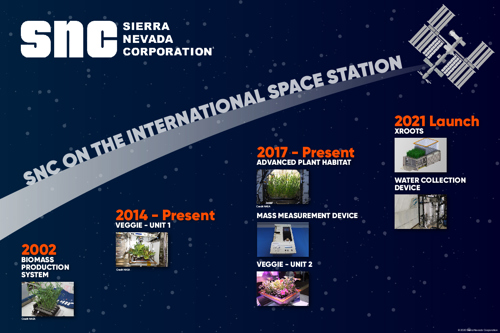SNC Celebrates International Space Station's 20th Anniversary
November 02, 2020
This November marks the 20th anniversary of a constant human presence on the International Space Station. SNC extends huge congratulations to the entire space community, including NASA and international partners on this important moment!
SNC is proud to have provided systems for the space station, including the Biomass Production System, Veggie, Advanced Plant Habitat and the Mass Measurement Device. These tools have advanced our understanding of living in space and will continue to help solve complex problems in a zero-g environment with cutting-edge solutions. SNC has additional equipment launching in 2021 for water flow and collection, and aeroponic plant growth and even more systems possible in the near future relevant to trash management and advanced life support.
The first mission to the space station, Expedition 1, brought three astronauts with equipment, supplies and science experiments. They stayed for 136 days, and Expedition 2 immediately followed. Since their historic stay, a total of 241 people from 19 countries have spent time aboard the space station over the past two decades.
Many of those astronauts visiting the space station have had the opportunity to utilize the plant growth systems and scientists benefit from real-time weigh-ins of their biological specimens with the zero gravity mass measurement device SNC developed for NASA.
Here’s a little more on the history of how SNC helps astronauts eat fresh food, enjoy a few zen moments of gardening, and conduct meaningful science on the space station to learn more about plants on Earth! We are also expecting to launch new items to the space station in 2021 which would impact advanced life support systems for our missions to the Moon and to Mars.
Plant Growth Systems
SNC’s Biomass Production System (BPS) arrived on the space station in 2002. It’s the first of our plant growth systems to be utilized on the space station. This system gained notoriety for the longest plant science experiments in a closed environment, and successfully recycled water transpired from the plants back into the root system to save water and crew time. Astronauts used it to grow wheat and Rapid Cycle Brassica, a plant in the mustard family with a fast life cycle used in research and education. BPS stayed on-orbit for nearly 75 days where astronauts performed eight harvests. At the time this experiment was performed, it was the longest continuous U.S. plant growth experiment in space. (SNC would later exceed that with Veggie and the Advanced Plant Habitat.) The plants grown in the BPS were not for consumption, but primarily to research photosynthesis in space and test our microgravity plant culture technology.
Shortly after this success, SNC started working on Veggie. The concept was to grow vegetables on the space station for astronauts to eat. The first unit arrived at the station in 2014, with the second arriving in 2017. Both are still there today, successfully growing plants like lettuce, Chinese cabbage, Mizuna mustard, Kale, and Zinnias while also supporting several plant biology experiments.
Also in 2017, SNC sent the Advanced Planet Habitat (APH) to the space station. It’s the largest plant growth chamber developed for the space station to date. APH is used for plant research in microgravity and can be remotely operated by scientists on Earth. There are nearly 200 sensors keeping track of information like plant water intake, plant development and CO2 levels. Astronauts are able to access gas samples from the growth chamber’s atmosphere and fluid samples from the root zones.
Mass Measurement Device
Scientists can also now weigh their scientific specimens on orbit, in zero gravity using SNC’s Mass Measurement Device (MMD). It’s been aboard and operating on the space station since 2017. Using Newton’s law of motion, this facility provides astronauts the ability to measure mass of specimens they put in the MMD, with accuracies better than 0.1 grams. Up until 2017, astronauts didn’t have a reliable way to measure mass on the space station. Now they have used it to weigh a variety of biological samples, including Mizuna mustard grown in Veggie!
What’s Launching Next - XROOTS & Water Capture Device:
Looking to the future in 2021, SNC is anticipating the launch of its eXposed Root On-Orbit Test System (XROOTS). It will be mounted in Veggie once it arrives at the space station. Its purpose is to evaluate hydroponic and aeroponic nutrient delivery for plant growth systems in a microgravity environment.
SNC also will be launching its Water Capture Device (WCD) to the space station to conduct technology demonstrations. The purpose of this device is to condense, separate and capture water droplets entrained in an air stream, providing recovery of water for reuse. Once it’s set up on the space station, it will require minimal crew interaction. SNC will support operational testing from our Payload Operations Center in Madison, Wisconsin.
Our unique capabilities stem from more than 20 years of research in environmental control and life-support systems for NASA. SNC is proud of our involvement with space station operations as the critical orbital laboratory that will inform a much more efficient, reliable, and comfortable trips to the Moon and to Mars. We look forward to continuing our support of human spaceflight operations in low-Earth orbit and to other far-flung regions.
